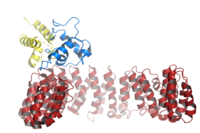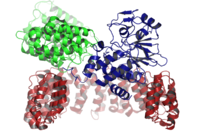Biology:Small tumor antigen

The small tumor antigen (also called the small T-antigen and abbreviated STag or ST) is a protein encoded in the genomes of polyomaviruses, which are small double-stranded DNA viruses. STag is expressed early in the infectious cycle and is usually not essential for viral proliferation, though in most polyomaviruses it does improve replication efficiency. The STag protein is expressed from a gene that overlaps the large tumor antigen (LTag) such that the two proteins share an N-terminal DnaJ-like domain but have distinct C-terminal regions. STag is known to interact with host cell proteins, most notably protein phosphatase 2A (PP2A), and may activate the expression of cellular proteins associated with the cell cycle transition to S phase. In some polyomaviruses - such as the well-studied SV40, which natively infects monkeys - STag is unable to induce neoplastic transformation in the host cell on its own, but its presence may increase the transforming efficiency of LTag.[2] In other polyomaviruses, such as Merkel cell polyomavirus, which causes Merkel cell carcinoma in humans, STag appears to be important for replication and to be an oncoprotein in its own right.[3]
Structure and expression

The genes for both the small and the large tumor antigen are encoded in the "early region" of the polyomavirus genome, so named because this region of the genome is expressed early in the infectious process. (The "late region" contains genes encoding the viral capsid proteins.) The early region typically contains at least two genes and is transcribed as a single messenger RNA processed by alternative splicing. The LTag gene is usually encoded in two exons, of which the first overlaps with the gene for STag (and sometimes other tumor antigens as well, such as the murine polyomavirus middle tumor antigen).[2][5][6] Polyomavirus STag proteins are usually around 170-200 residues long and consist of two distinct regions as a result of this genetic encoding. STag and LTag share a common N-terminal domain called the J domain, which is around 80-90 residues long, has homology to DnaJ proteins, and functions as a molecular chaperone.[2][7]
The C-terminal portion of the STag protein is distinct from LTag but shares an additional ~100 residues with middle tumor antigen in those viruses that express it, such as murine polyomavirus.[8] The C-terminal region of STag contains a protein phosphatase 2A binding region, followed in mammalian polyomaviruses by a metal ion binding region at the C-terminus with conserved cysteine-containing sequence motifs.[2] These are believed to bind zinc in the SV40 STag and confer improved protein stability,[2][9][10] but in Merkel cell polyomavirus STag, they have been reported to bind iron-sulfur clusters.[3] Among polyomaviruses that infect birds - classified in the genus Gammapolyomavirus - the conserved cysteines characterizing these metal-binding regions are not present and there is no detectable sequence homology between the avian and mammalian STag C-termini.[11]
Function
The exact functional role of STag varies among polyomaviruses. In SV40 and JC virus, STag is not required for viral proliferation, but does improve efficiency. In SV40, STag has a similar role in cellular transformation.[2] In Merkel cell polyomavirus, it appears to play a significant role in oncogenesis, a function performed primarily by LTag in other polyomaviruses.[3] Where the tumor antigens' subcellular localization has been characterized, STag is usually located in the cytoplasm.[8]
Viral replication
In most well-studied polyomaviruses, STag improves the efficiency of viral proliferation but is not essential. SV40 and murine polyomavirus STags appear to have a role in promoting host cell expression of genes under the control of certain types of promoters. This function is mediated by the J domain, presumably indirectly as STag has no DNA-binding ability of its own. Both STag and LTag interact through their J domains with Hsc70 to increase its ATPase activity.[2]
Effects on the cell cycle
Because polyomavirus genome replication relies on the DNA replication machinery of the host cell, the cell must be in S phase (the part of the cell cycle in which the host cell's genome is normally replicated) in order to provide the necessary molecular machinery for viral DNA replication. Viral proteins therefore promote dysregulation of the cell cycle and entry into S phase. This function is usually primarily provided by LTag through its interactions with retinoblastoma protein and p53.[7][13]
STag contributes to this process through its interaction with protein phosphatase 2A (PP2A).[14] The active form of PP2A consists of a heterotrimer assembly of three subunits. X-ray crystallography of the STag-PP2A protein complex demonstrates that STag replaces one subunit in the complex, thereby inactivating it.[2][1][15][16]
Cellular transformation
Some, but not all, polyomaviruses are oncoviruses capable of inducing neoplastic transformation in some cells. In oncogenic polyomaviruses, the tumor antigens are responsible for the transformation activity, although the exact molecular mechanisms vary from one virus to another.[13][7][17] STag is usually not capable of inducing these effects on its own, but increases efficiency of transformation or is sometimes a required component in addition to LTag.[2] In most polyomaviruses, STag's effect on transformation is mediated through its interaction with PP2A.[16]
Distinct functions in Merkel cell polyomavirus
Merkel cell polyomavirus (MCPyV) is a virus causally associated with a rare and aggressive human skin cancer called Merkel cell carcinoma. MCPyV genetic material is often found integrated into the tumor cell genome, usually with mutations in the tumor antigen genes that abrogate the helicase activity of LTag, which is required for normal viral replication.[3][18] In MCPyV, STag, rather than LTag, is the primary oncoprotein, is found in Merkel cell carcinomas more often than LTag, is required for tumor growth, and has additional pro-transformation effects independent of its PP2A-binding activity. MCPyV STag is believed to induce dysregulation of cap-dependent translation by promoting phosphorylation of eukaryotic translation initiation factor 4E-BP1.[19] In vivo studies in rodent animal models suggest that MCPyV STag alone can be sufficient to drive transformation.[20]
References
- ↑ 1.0 1.1 1.2 Cho, Uhn Soo; Morrone, Seamus; Sablina, Anna A.; Arroyo, Jason D.; Hahn, William C.; Xu, Wenqing (2007-08-01). "Structural basis of PP2A inhibition by small t antigen". PLOS Biology 5 (8): e202. doi:10.1371/journal.pbio.0050202. ISSN 1545-7885. PMID 17608567.
- ↑ 2.0 2.1 2.2 2.3 2.4 2.5 2.6 2.7 2.8 Khalili, K; Sariyer, IK; Safak, M (May 2008). "Small tumor antigen of polyomaviruses: role in viral life cycle and cell transformation.". Journal of Cellular Physiology 215 (2): 309–19. doi:10.1002/jcp.21326. PMID 18022798.
- ↑ 3.0 3.1 3.2 3.3 Tsang, Sabrina H.; Wang, Ranran; Nakamaru-Ogiso, Eiko; Knight, Simon A. B.; Buck, Christopher B.; You, Jianxin; Banks, L. (1 February 2016). "The Oncogenic Small Tumor Antigen of Merkel Cell Polyomavirus Is an Iron-Sulfur Cluster Protein That Enhances Viral DNA Replication". Journal of Virology 90 (3): 1544–1556. doi:10.1128/JVI.02121-15. PMID 26608318.
- ↑ Gaynor, Anne M.; Nissen, Michael D.; Whiley, David M.; Mackay, Ian M.; Lambert, Stephen B.; Wu, Guang; Brennan, Daniel C.; Storch, Gregory A. et al. (2007-05-04). "Identification of a novel polyomavirus from patients with acute respiratory tract infections". PLOS Pathogens 3 (5): e64. doi:10.1371/journal.ppat.0030064. ISSN 1553-7374. PMID 17480120.
- ↑ Moens, U.; Van Ghelue, M.; Johannessen, M. (5 May 2007). "Oncogenic potentials of the human polyomavirus regulatory proteins". Cellular and Molecular Life Sciences 64 (13): 1656–1678. doi:10.1007/s00018-007-7020-3. PMID 17483871.
- ↑ Van Ghelue, Marijke; Khan, Mahmud Tareq Hassan; Ehlers, Bernhard; Moens, Ugo (November 2012). "Genome analysis of the new human polyomaviruses". Reviews in Medical Virology 22 (6): 354–377. doi:10.1002/rmv.1711. PMID 22461085.
- ↑ 7.0 7.1 7.2 Topalis, D.; Andrei, G.; Snoeck, R. (February 2013). "The large tumor antigen: A "Swiss Army knife" protein possessing the functions required for the polyomavirus life cycle". Antiviral Research 97 (2): 122–136. doi:10.1016/j.antiviral.2012.11.007. PMID 23201316.
- ↑ 8.0 8.1 Cheng, Jingwei; DeCaprio, James A.; Fluck, Michele M.; Schaffhausen, Brian S. (2009). "Cellular transformation by Simian Virus 40 and Murine Polyoma Virus T antigens". Seminars in Cancer Biology 19 (4): 218–228. doi:10.1016/j.semcancer.2009.03.002. PMID 19505649.
- ↑ Turk, B; Porras, A; Mumby, MC; Rundell, K (June 1993). "Simian virus 40 small-t antigen binds two zinc ions.". Journal of Virology 67 (6): 3671–3. doi:10.1128/jvi.67.6.3671-3673.1993. PMID 8388518.
- ↑ Goswami, R; Turk, B; Enderle, K; Howe, A; Rundell, K (March 1992). "Effect of zinc ions on the biochemical behavior of simian virus 40 small-t antigen expressed in bacteria.". Journal of Virology 66 (3): 1746–51. doi:10.1128/jvi.66.3.1746-1751.1992. PMID 1310775.
- ↑ Buck, Christopher B.; Van Doorslaer, Koenraad; Peretti, Alberto; Geoghegan, Eileen M.; Tisza, Michael J.; An, Ping; Katz, Joshua P.; Pipas, James M. et al. (19 April 2016). "The Ancient Evolutionary History of Polyomaviruses". PLOS Pathogens 12 (4): e1005574. doi:10.1371/journal.ppat.1005574. PMID 27093155.
- ↑ Cho, Uhn Soo; Xu, Wenqing (2007-01-04). "Crystal structure of a protein phosphatase 2A heterotrimeric holoenzyme". Nature 445 (7123): 53–57. doi:10.1038/nature05351. ISSN 1476-4687. PMID 17086192. Bibcode: 2007Natur.445...53C.
- ↑ 13.0 13.1 An, Ping; Sáenz Robles, Maria Teresa; Pipas, James M. (13 October 2012). "Large T Antigens of Polyomaviruses: Amazing Molecular Machines". Annual Review of Microbiology 66 (1): 213–236. doi:10.1146/annurev-micro-092611-150154. PMID 22994493.
- ↑ Pallas, David C.; Shahrik, Lilian K.; Martin, Bruce L.; Jaspers, Stephen; Miller, Thomas B.; Brautigan, David L.; Roberts, Thomas M. (January 1990). "Polyoma small and middle T antigens and SV40 small t antigen form stable complexes with protein phosphatase 2A". Cell 60 (1): 167–176. doi:10.1016/0092-8674(90)90726-U. PMID 2153055.
- ↑ Chen, Y; Xu, Y; Bao, Q; Xing, Y; Li, Z; Lin, Z; Stock, JB; Jeffrey, PD et al. (June 2007). "Structural and biochemical insights into the regulation of protein phosphatase 2A by small t antigen of SV40.". Nature Structural & Molecular Biology 14 (6): 527–34. doi:10.1038/nsmb1254. PMID 17529992.
- ↑ 16.0 16.1 Sablina, Anna A.; Hahn, William C. (23 January 2008). "SV40 small T antigen and PP2A phosphatase in cell transformation". Cancer and Metastasis Reviews 27 (2): 137–146. doi:10.1007/s10555-008-9116-0. PMID 18214640.
- ↑ Stakaitytė, Gabrielė; Wood, Jennifer J.; Knight, Laura M.; Abdul-Sada, Hussein; Adzahar, Noor Suhana; Nwogu, Nnenna; Macdonald, Andrew; Whitehouse, Adrian (2014-06-27). "Merkel Cell Polyomavirus: Molecular Insights into the Most Recently Discovered Human Tumour Virus" (in en). Cancers 6 (3): 1267–1297. doi:10.3390/cancers6031267. PMID 24978434.
- ↑ Wendzicki, Justin A.; Moore, Patrick S.; Chang, Yuan (2015-04-01). "Large T and small T antigens of Merkel cell polyomavirus". Current Opinion in Virology 11: 38–43. doi:10.1016/j.coviro.2015.01.009. ISSN 1879-6265. PMID 25681708.
- ↑ Shuda, Masahiro; Kwun, Hyun Jin; Feng, Huichen; Chang, Yuan; Moore, Patrick S. (1 September 2011). "Human Merkel cell polyomavirus small T antigen is an oncoprotein targeting the 4E-BP1 translation regulator". Journal of Clinical Investigation 121 (9): 3623–3634. doi:10.1172/JCI46323. PMID 21841310.
- ↑ Verhaegen, Monique E.; Mangelberger, Doris; Harms, Paul W.; Vozheiko, Tracy D.; Weick, Jack W.; Wilbert, Dawn M.; Saunders, Thomas L.; Ermilov, Alexandre N. et al. (2015). "Merkel Cell Polyomavirus Small T Antigen Is Oncogenic in Transgenic Mice". Journal of Investigative Dermatology 135 (5): 1415–1424. doi:10.1038/jid.2014.446. PMID 25313532.



